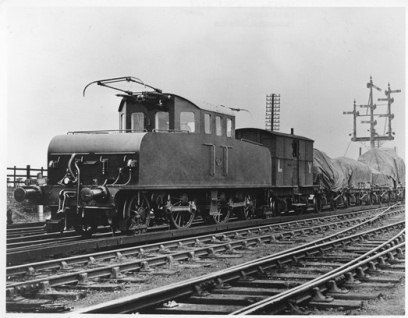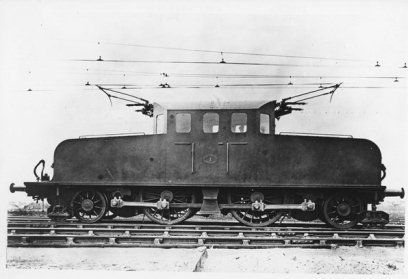These rare photographs, courtesy of the Lancashire & Yorkshire Railway Society (http://www.lyrs.org.uk/) show Lancashire & Yorkshire Railway No 1, the first of two electric locomotives by the Lancashire & Yorkshire. It was built in August 1912 to the 2-4-2 configuration, meaning that it has four main, powered wheels and two 'trailing' wheels at either side. This is very unusual for an electric locomotive which usually has all of the wheels powered, and not just that, but as can be seen the powered wheels are coupled together which is again very unusual for an electric locomotive (in fact I can't think of any other electric locomotive with coupling rods). This is similar to the 2-4-2T (Tank) steam locomotives also built by the railway.
The steel body on top of the chassis has the driver's compartment in the centre similar to electric locomotives of the time, often known as the 'steeplecab', and can collect the electricity from shoes which pick up the current from a third, electrified, rail alongside the railway track, or from overhead wires. When it entered service, it did little work apart from trials and from 1914-18 was sheeted over and stored in the paint shop at the Lancashire & Yorkshire's Horwich works, but towards the end of 1918 was transferred to the Liverpool and Southport electrified line and used to haul freight. It was known to have poor riding qualities and on a few occasions had to be rescued by a steam locomotive when it broke down. No 1 was soon taken out of service and scrapped in 1922.
My thanks go to the Lancashire & Yorkshire Railway Society for letting me use these images, they have different images of this locomotive and other Edwardian railway images on their superb website;





Electric locomotives with coupling rods: The Deutsche Reichsbahn used a lot of them in the 20s: E32, E36, E50, E52, E60, E63, E75, E77, E91, to name a few, with drives from simple C and C1 of switchers via B'-B's to heavy C'-C's. There was one, I don't remember the number, that was a D or an E with one single motor with a diameter of 3.36meter. For your info: a figure is a non-driven axle, a letter a driven one, an apostrophe means it is in a separate block, and a small o means every axle has its own motor. So a 2-B'-B'-2 like the E52 is translated as 4-4-4-4 with one motor driving each block of 2 driven axles. A Co'-Co' is a 6-6 with every axles driven by its own motor. This locomotive in the picture is a 1-B-1.
ReplyDeleteEd.
I disagree with Anonymous about the wheel notation. In my experience, siderod-driven electric or internal combustion locomotives are often referred to using the Whyte notation i.e. (in this case) 2-4-2. S/he has also neglected to mention probably the most famous of all siderod electrics, namely the Swiss "Krokodils".
ReplyDeleteThere were over 1000 rod-driven electric locomotives worldwide, many of them designed by the hungarian engineer Kalman Kando. Italy alone used over 700 of them, on their double-catenary, three-phase 3kV/16.7Hz traction system between 1902-1976. In fact, rod drive was mandatory for almost all AC-motor driven electric locomotives in the pre-GTO/IGBT era! That's because fine RPM control was not possible without solid state devices and the axle with the worn (smaller dia.) wheels wouldn't pull at all. The rods forced all axles to turn uniformly, so spinout was prevented.
ReplyDelete> There was one, I don't remember the number, that was a D or an E with one single motor with a diameter of 3.36meter <
ReplyDeleteYou may be thinking about this one: the hungarian V40 (1D1, express/universal) and V60 (E, six-axle heavy freight) electric locomotives had a single very large 18-ton, 2500/3500hp polyphase AC traction motor. Over 3 meters in dia., it was so large it barely fit in the UIC gauge profile. There was also a 12-ton synchronous rotary phase converter device onboard, which mangled the single-wire 16kV/50Hz AC catenary feed into ~1200V polyphase AC for the big motor. The wheels were rod-driven. About three dozen of them served between 1932 and 1967. Only one V40 and one V60 survived as static displays.
There were some early-20th century electric locomotives in the US with wheels driven by a jackshaft and side-rods, such as the DD1 class (1911) on the Pennsylvania Railroad. This method of transmission was chosen becauseat that time, electric motors of the power required were too large to be mounted on the axles. (See photo on the Wikipedia page for "PRR DD1", showing a giant motor in the body of the locomotive).
ReplyDelete